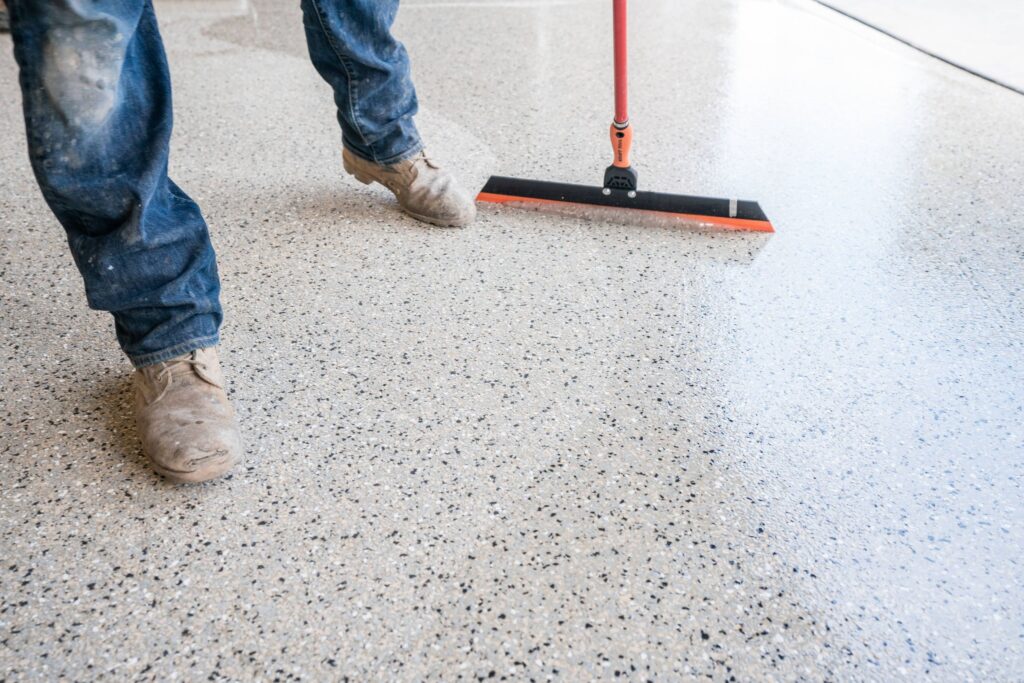The garage floor goes through a lot. The surface gets more wear and tear than most other sections of your home. It is hit by heavy cars, chemical spills, temperature changes, and foot traffic. It’s not just about looks when you choose the appropriate floor coating.
It’s also about protecting the concrete underneath, making things safer, and making maintenance easier in the long run. So, what kind of coating can really handle the pressure?
Understanding the Demands on Garage Floors
It’s crucial to know what a garage floor has to deal with every day before you start talking about specific materials. Floors have to hold the weight of parked automobiles, and they also have to deal with oil spills, battery acid, lost tools, de-icing salt in the winter, and even wetness from the ground. So, durability and resistance are now the most important things
You can explore insights from a rubber flooring expert here for more in-depth knowledge on floor surfaces that need to handle stress, especially in utilitarian spaces.
Key Qualities of a Good Garage Floor Coating
To narrow down your options, let’s define what makes a coating truly effective:
- Toughness: It should withstand heavy loads without cracking or peeling.
- Chemical Resistance: Oil, coolant, and gasoline shouldn’t leave permanent stains.
- Moisture Protection: Coatings must guard against water seepage and vapor intrusion.
- Slip Resistance: A slightly textured or grippy surface reduces fall risk.
- Ease of Cleaning: Dust, grime, and liquids should clean up easily.
- Longevity: The coating should last for years with minimal upkeep.
Most Common Garage Floor Coating Options
Let’s dive into the main contenders and assess how each holds up in a real-world garage environment.
1. Epoxy Coating
Epoxy is virtually always used on garage flooring, and for good reason. Once it dries, it makes a surface that is as hard as a rock. Epoxy sticks very well to concrete, making a smooth surface that is easy to sweep and mop.
Pros:
- Excellent durability and hardness
- Highly resistant to chemicals and abrasion
- Available in various colors and finishes, including flake styles
- Can last 5 to 10 years with proper application
Cons:
- Requires a clean, dry, and etched surface to bond properly
- Can become slippery when wet unless texture is added
- Sensitive to temperature and humidity during application
2. Polyaspartic Coating
A newer entry in the market, polyaspartic coatings cure faster and offer flexibility that epoxy doesn’t. They’re ideal for those who want a quick turnaround without sacrificing strength.
Pros:
- Fast drying time (can be completed in one day)
- UV stable — won’t yellow over time
- More flexible than epoxy, reducing risk of cracking
- High resistance to chemicals and moisture
Cons:
- More expensive than epoxy
- Requires professional installation for best results
3. Polyurethane Coating
Often used as a topcoat over epoxy, polyurethane adds an extra layer of protection. It’s more elastic than epoxy, which can help prevent cracks caused by temperature changes.
Pros:
- Strong chemical and abrasion resistance
- Better UV resistance compared to epoxy
- Slightly flexible
Cons:
- Not as thick as epoxy — usually needs to be applied over another base
- More sensitive to moisture during installation
4. Concrete Sealers (Acrylic or Penetrating Types)
If you’re looking for a budget-friendly option, concrete sealers might suffice. While not technically “coatings” in the traditional sense, they still offer a level of protection.
Pros:
- Easy to apply — often DIY-friendly
- Protects against moisture and minor staining
- Affordable
Cons:
- Limited protection against abrasion and heavy impact
- Requires more frequent reapplication (every 1-3 years)
5. Rubberized Flooring and Mats
While not a coating, rubberized roll-out mats or tiles are worth mentioning. They provide immediate coverage and can be combined with other coatings for added resilience.
Pros:
- Quick to install and replace
- Cushions falls and dropped tools
- Non-slip by nature
Cons:
- Can shift or bunch if not secured
- Might trap moisture underneath if floor isn’t sealed
Comparing Performance in Real Conditions
To determine what works best, consider the following performance factors:
| Coating Type | Chemical Resistance | Impact Resistance | Slip Resistance | Application Difficulty |
|---|---|---|---|---|
| Epoxy | High | High | Medium* | Moderate |
| Polyaspartic | High | Very High | Medium* | High (Pro recommended) |
| Polyurethane | High | Medium | Medium* | High |
| Sealer | Low-Medium | Low | Low | Easy |
| Rubber Mats | Medium | High | High | Easy |
*Can be improved with texture flakes or anti-slip additives.
When to Consider a Professional Installer
While DIY kits exist for epoxy and sealers, certain conditions call for expertise:
- High humidity or moisture-prone concrete
- Cracked or uneven surfaces
- Fast project timelines
- Desired color blending or decorative finishes
Professionals also use industrial-grade materials not available in most hardware stores, increasing both durability and aesthetic potential.
Final Thoughts: Which Is Best?
There isn’t one answer that fits all. Epoxy is a good choice for most garage owners because it is cheap, lasts a long time, and looks good. Polyaspartic is the best choice if you want faster curing and more versatility. A good sealant might work for garages that don’t get a lot of use.
Rubber flooring might be the best choice if you care more about comfort and slip protection, especially when used with sealed concrete.
Whichever path you take, investing in a quality coating today means fewer repairs, less dust, and better-looking floors for years to come. And if you’re also curious about enhancing your exterior, be sure to explore https://safestep.pro/rubber-crumb-driveways/ for practical ideas on driveway surfaces that complement your garage’s durability.

